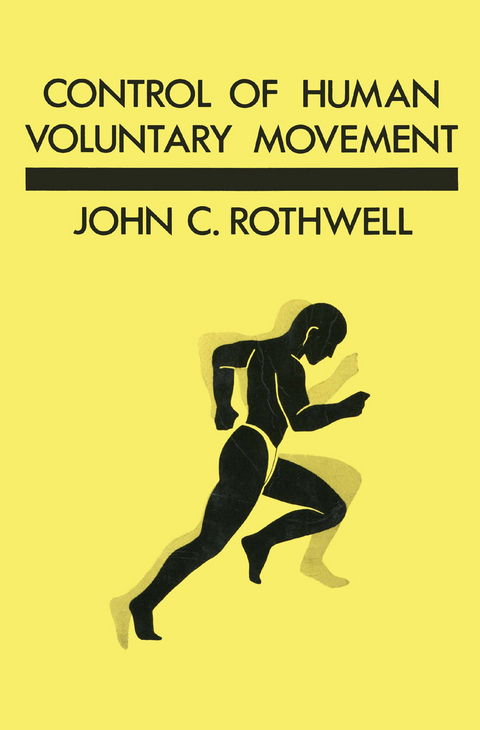
Control of Human Voluntary Movement
Springer-Verlag New York Inc.
978-1-4684-7690-3 (ISBN)
The human motor system is unique. It talks, walks and can play the piano from a remarkably early age. But it is difficult to study. One cannot impale single neurones with electrodes or lesion discrete areas of the nervous system in man. However, data gleaned from such elegant experiments in lower species that walk on four feet may not reflect the organisation of human motor mechanisms. John Rothwell is one of a small band of human-motor physiologists who have followed the dictum 'The proper study of mankind is man'. In this book, he brings together what is known about human motor physiology in an eminently readable and critical fashion. Of course, there is a stimulating symbiosis between animal and human experimental motor physiology, and this is effected by the integration of critical information that can only be obtained from work on animals with what is known about man. Many disciplines have interest in the mechanisms of human voluntary movement - physiologists, psychologists, physiotherapists and clinicians, be they neurologists or those working in orthopaedics, physical medicine or rehabilitation. All will find John Rothwell's book invaluable. To the beginner it provides an excellent introduction to the subject. To the expert it presents a coherent review of current knowledge and areas of uncertainty. What is abundantly clear is how much more remains to be discovered about how man controls movement. The stimulus provided by this volume will be invaluable to thought and experiment.
1. Introduction. Plans, Strategies and Actions.- Categories of Muscles.- Problems of Moving.- A Legacy.- 2. Mechanical Properties of Muscles.- Review of Muscle Anatomy.- Mechanical Properties of Muscle.- Behaviour of Isolated Muscle Stimulated at Subtetanic Rates.- Muscle Mechanics in Intact Man.- Effects of Muscle Properties on Control of Movement.- A Theory of Movement Control which Makes Use of the Mechanical Properties of Muscle.- 3. The Motor Unit.- The Concept of the Motor Unit.- Twitch and Tonic Muscle Fibres.- Physiological Investigation of the Motor Unit.- Histochemical and Biochemical Classification of Muscle Fibres.- Some Electrophysiological Properties of Motoneurones.- Control of Motor Units and their Recruitment Order.- The Study of Motor Units in Human Physiology.- Pathophysiology of the Motor Unit.- 4. Proprioceptors in Muscle, Joint and Skin.- Muscle Receptors: I. The Muscle Spindle.- Muscle Receptors: II. Golgi Tendon Organs.- Muscle Receptors: III. Other Types of Ending.- Joint Receptors.- Cutaneous Mechanoreceptors.- Recordings from Human Afferent Nerve Fibres.- 5. Reflex Pathways in the Spinal Cord.- Classification of Nerve Fibres.- Reflex Pathways from la Muscle Spindle Afferents.- Reflex Pathways from lb Tendon Organ Afferents.- Reflex Pathways from Group II Muscle Afferents and the ‘Flexor Reflex Afferents’.- The Renshaw Cell.- Integration in Spinal Reflex Pathways.- Presynaptic Inhibition.- 6. Functional Consequences of Activity in Spinal Reflex Pathways.- The Stretch Reflex in Animals.- Stretch Reflexes in Human Muscles.- The Servo Hypothesis and Alpha-Gamma Coactivation.- The Regulation of Stiffness Hypothesis and lb Effects.- Other Spinal Reflex Pathways.- Cutaneous Reflexes.- Pathophysiology of the Stretch Reflex: Disorders of MuscleTone.- Pathophysiology of Other Reflex Pathways.- 7. Ascending and Descending Pathways of the Spinal Cord.- Ascending Pathways.- 8. Cerebral Cortex.- Structure of Cerebral Cortex.- Detailed Electrophysiology of Primary Motor (MI) Cortex.- The Pyramidal Tract.- Motor Cortex Cell Activity During Voluntary Movements.- Sensory Input to Motor Cortex.- Other Motor Areas of Cortex.- Supplementary Motor Area.- Motor Functions of Parietal Cortex.- Pathophysiology of Motor Areas of Cerebral Cortex.- 9. The Cerebellum.- Cerebellar Anatomy.- Electrophysiological Studies of the Cerebellum.- Effects of Cerebellar Lesions.- Studies of Cerebellar Dysfunction in Man.- Theories of Cerebellar Function.- 10. The Basal Ganglia.- Anatomy.- Electrophysiological Recordings from Behaving Animals.- Pathophysiology of Diseases of the Basal Ganglia in Man.
| Erscheint lt. Verlag | 19.4.2012 |
|---|---|
| Zusatzinfo | XVI, 326 p. |
| Verlagsort | New York, NY |
| Sprache | englisch |
| Maße | 155 x 235 mm |
| Themenwelt | Sachbuch/Ratgeber ► Natur / Technik ► Garten |
| Schulbuch / Wörterbuch ► Lexikon / Chroniken | |
| Geisteswissenschaften | |
| Naturwissenschaften | |
| Sozialwissenschaften | |
| ISBN-10 | 1-4684-7690-4 / 1468476904 |
| ISBN-13 | 978-1-4684-7690-3 / 9781468476903 |
| Zustand | Neuware |
| Haben Sie eine Frage zum Produkt? |
aus dem Bereich


